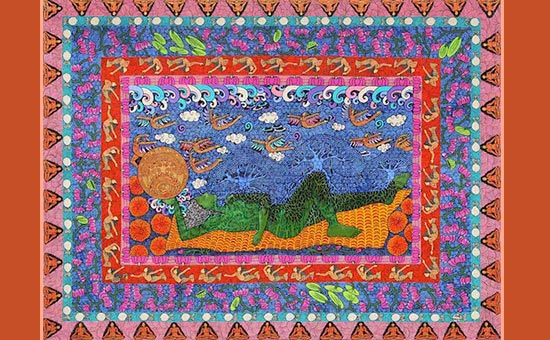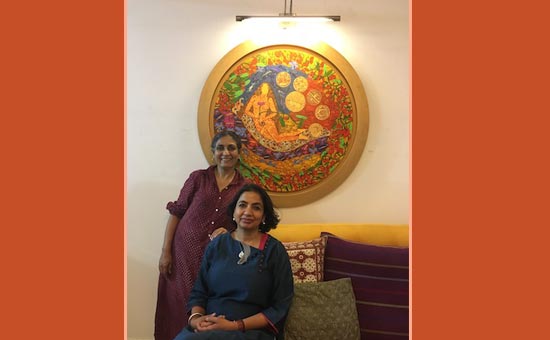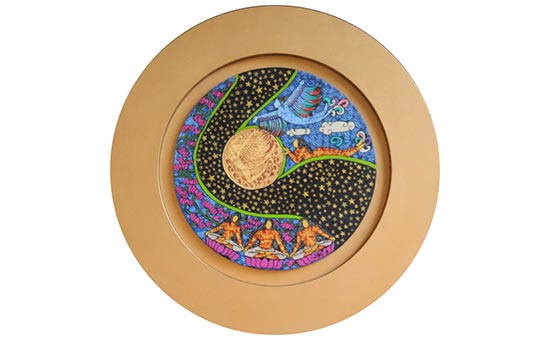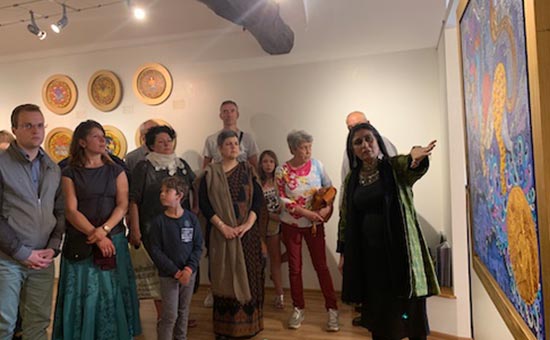- Sonia Nayyar Patwardhan, the curator and founder of Laasya Art
gallery in Palo Alto, California, recently interviewed contemporary Indian
artist Seema Kohli about her art, journey and
philosophy of life.
Seema Kohli is a
distinguished contemporary artist and one of the most respected women artists
in India, a true living legend. Known for her intricate and surreal depictions
of women, each of her works incorporates multilayered stories from myths,
spirituality and philosophy, from lotus flowers to the Tree of Life. Her
hard-won confidence and inner peace shine through these painted celebrations of
feminine power.
Over the years, I
have been lucky to get to know Seema personally and professionally through my
gallery Laasya Art, so we recently spoke on
the occasion of her current major solo show at the Museum of Sacred Art
outside of Brussels, on view through December 2019. This in-depth exhibition
highlights her creative achievements across more than 200 paintings, murals,
films, installations, performances and sculptures. Seema is open, authentic and
bold, and I hope this excerpt of our interview translates the amazing
experience of speaking with her.
 Acrylic and ink on canvas with 24ct gold and silver leaf, 36 x 48 inches.
Acrylic and ink on canvas with 24ct gold and silver leaf, 36 x 48 inches.
Sonia:
Tell me a little bit about your journey as an artist. You call yourself a
self-taught artist, right?
Seema: I say all
artists are self-taught, because being an artist is about the individual
language. Institutions are important for us to understand the mediums, and you
can get inquisitive and have dialogue with so many different people and
artists. I did attend South Delhi Polytechnic, Triveni and I owe a lot to those
institutions and most
importantly the institution of family. But, becoming an artist is a very
internal journey and you have to explore within yourself and learn your own
language.
In one of your books, you write about how you married young and how you felt ‘subservient,’ that you only painted in the night time. What was that time in your life like?
It is a very personal statement that I made there — ‘subservient’ — I can't blame anyone for that. At the time, it felt very important for me to play these roles and play them right. But this obstructed my art because I was somebody's wife, somebody's daughter, somebody's daughter-in-law, somebody's sister-in-law and even somebody's mother. It is only later that I realised that being a mother was a liberating kind of experience, because I think children are the first critics, and they really help you grow. They are the ones who push you to the boundaries.
 Seema Kohli with the author, Sonia Nayyar Patwardhan.
Seema Kohli with the author, Sonia Nayyar Patwardhan.
So what I meant by
subservient was that I was obstructing my internal growth as an artist and my
expression as an artist. I was very careful with what I was drawing, how much
time I was giving to art so that it should not affect my duties as a housewife.
It came to a point where I had a breakdown and decided to leave my marriage.
Faith and a little madness got me through. I just knew I was free to paint, I was so happy to get up and have tea with my canvas. I felt that I cheated on my art by not giving it respect, and now that I had got my opportunity, I shouldn’t leave it a moment. I was happy that my fate and my ancestors blessed me with this time.
But you weren’t angry with anyone.
The moment you are true to yourself, the bitterness goes away. You understand not only yourself but also the other — there is nothing to be bitter about, because everyone plays their role according to their own ‘samskaras.’
 Acrylic and ink on canvas with 24ct gold and silver leaf, 12 inches diameter.
Acrylic and ink on canvas with 24ct gold and silver leaf, 12 inches diameter.
And
somewhere along the way, you discovered how to be true to yourself.
When I was
painting before, I would think a lot about it and do a lot of sketches. Now I
don't do any sketches at all. Whatever I feel like from within, I let it just
flow, and that's how I know I'm more at peace now.
You
mentioned your fate and your ancestors. Can you talk more about that?
My grandfather was a spiritual and awakened soul. My father was too, and the whole family atmosphere was congenial. We didn't have a temple in the house, but we knew a lot of mantras. Once when I was 3 or so, I couldn’t sleep so I learnt Gayatri Mantra, and it became a habit. I was lucky to have a very secular upbringing were we didn’t have a prejudice towards any religion or the sense of belonging to a particular religion.
 At the opening of her 2019 solo exhibition at the Museum of Sacred Art in Brussels, Seema explains her painting of Krishna becoming one with all animal forms.
At the opening of her 2019 solo exhibition at the Museum of Sacred Art in Brussels, Seema explains her painting of Krishna becoming one with all animal forms.
How
can the story of your journey be useful to other artists?
Artists have to
accept certain aspects of ourselves which are selfish, but this is not a
negative thing. Are you honest to yourself, doing something for yourself? By
the time you are creating something of your own, you are also giving something
to society, to others. The fragrance of the society is art. But not all are
artists or can be artists.
Is there
transparency between you and yourself? When you wake up, do you see yourself in
your paintings? If there is a difference, then you need to work on it.
Thank
you so much Seema.
All pictures by
Seema Kohli.
DISCLAIMER AND
CREDITS: All images are reproduced here courtesy of the artists and Laasya Art
gallery, Palo Alto. They may not be reproduced elsewhere without written
permission from Laasya Art.